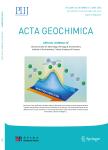How to estimate isotope fractionations of a Rayleigh-like but diffusion-limited disequilibrium process?
How to estimate isotope fractionations of a Rayleigh-like but diffusion-limited disequilibrium process?作者机构:School of Earth and Space SciencePeking UniversityBeijing 100871China State Key Laboratory of Ore Deposit GeochemistryInstitute of GeochemistryChinese Academy of SciencesGuiyang 550081China International Center for Planetary ScienceCollege of Earth ScienceChengdu University of TechnologyChengdu 610059China CAS Center for Excellence in Comparative PlanetologyHefei 230026China
出 版 物:《Acta Geochimica》 (地球化学学报(英文))
年 卷 期:2023年第42卷第1期
页 面:24-37页
核心收录:
学科分类:070902[理学-地球化学] 0709[理学-地质学] 07[理学]
基 金:supported by the Strategic Priority Research Program (B) of CAS (No. XDB41000000) Pre-research Project on Civil Aerospace Technologies No. D020202 funded by the Chinese National Space Administration (CNSA) and Chinese NSF projects (No. 42130114)
主 题:Isotope fractionation Reservoir isotope effect Rayleigh-like distillation process Diffusional isotope effect Numerical modeling Disequilibrium process
摘 要:The Rayleigh distillation isotope fractionation(RDIF) model is one of the most popular methods used in isotope geochemistry. Numerous isotope signals observed in geologic processes have been interpreted with this model. The RDIF model provides a simple mathematic solution for the reservoir-limited equilibrium isotope fractionation effect. Due to the reservoir effect, tremendously large isotope fractionations will always be produced if the reservoir is close to being depleted. However, in real situations, many prerequisites assumed in the RDIF model are often difficult to meet. For instance, it requires the relocated materials, which are removed step by step from one reservoir to another with different isotope compositions(i.e., with isotope fractionation), to be isotopically equilibrated with materials in the first reservoir simultaneously. This ‘‘quick equilibrium requirement’’ is indeed hard to meet if the first reservoir is sufficiently large or the removal step is fast. The whole first reservoir will often fail to re-attain equilibrium in time before the next removal *** problem led the RDIF model to fail to interpret isotope signals of many real situations. Here a diffusion-coupled and Rayleigh-like(i.e., reservoir-effect included) separation process is chosen to investigate this problem. We find that the final isotope fractionations are controlled by both the diffusion process and the reservoir effects via the disequilibrium separation process. Due to its complexity, we choose to use a numerical simulation method to solve this problem by developing specific computing codes for the working *** to our simulation results, the classical RDIF model only governs isotope fractionations correctly at the final stages of separation when the reservoir scale(or thickness of the system) is reduced to the order of magnitude of the quotient of the diffusivity and the separation rate. The RDIF model fails in other situations and the isotope fractionations



